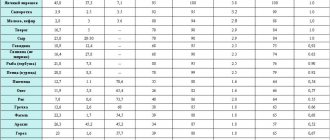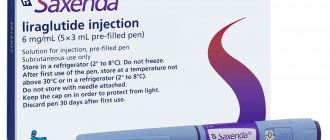Updated: 04/23/2021 15:12:57
Expert: Abramova Tsilya
| Reduxin | |
| Advantages | Flaws |
| High therapeutic efficiency | Many contraindications |
| Rapid weight loss for obesity | High risk of side effects |
| Convenient appointment – once a day | |
| Well tolerated | |
| Reduxin Met | |
| Advantages | Flaws |
| Improved composition | Even more contraindications |
| Use for obesity caused by diabetes mellitus | Additional adverse reactions |
| You can achieve lasting results | High price |
Description of the product Reduxin and Reduxin Met
Reduxin based on sibutramine and MCC is available in capsules. This is a prescription medicine for the treatment of excess body weight. Actions: anorexigenic and enterosorbing.
Reduxin Met is an improved version of the drug. Available in tablets and capsules, which are sold in one package. Tablets contain metformin, capsules contain sibutramine.
Reduxin and Reduxin Met have a similar effect and have the same indications and contraindications. They are distinguished by their method of application, dosage and cost. Reduxin Met has an additional property – hypoglycemic.
Sibutramine is a medicinal substance that affects the feeling of satiety. It reduces the need to eat. MCC is a sorbent with a detoxification effect. Microcrystalline cellulose binds and removes toxic substances and allergens.
Metformin is a hypoglycemic substance that does not lead to hypoglycemia in healthy people. It stimulates glycogen synthesis and has a beneficial effect on metabolism. Taking this remedy leads to a gradual weight loss or it remains stable.
Both drugs are potent drugs that can only be used for strict indications for the treatment of obesity. They cannot be used for weight loss without concomitant diseases. The drugs have many contraindications and side symptoms.
Research and effectiveness
When using the drug Reduxin for the treatment of obesity, positive results are observed within 4 weeks. Loss of body weight occurs mainly due to adipose tissue. The drug is well tolerated. While taking the medication, patients experience a decrease in hunger and a reduction in the number of unplanned snacks.
Therapy with Reduxin in most cases achieves the desired effect in metabolic syndrome. When combined with lifestyle changes, treatment becomes more effective.
Source: “Experience of using the drug Reduxin in patients with metabolic syndrome.” Butrova S.A. Obesity and metabolism. 2007.
Contraindications
Restrictions on the use of Reduxin:
- hypersensitivity to the composition;
- mental illness;
- organic causes of excess weight, such as hypothyroidism;
- generalized tics;
- CVD diseases;
- thyrotoxicosis;
- bulimia, anorexia;
- hypertension;
- severe kidney and liver pathologies;
- pregnancy, before 18 and after 65 years;
- prostate hyperplasia;
- drug and alcohol addiction;
- angle-closure glaucoma.
Reduxin Met additionally has the following restrictions for use:
- diabetic coma;
- exacerbation of chronic diseases;
- previous surgery, trauma;
- hypocaloric diet;
- 48 hours before and after x-rays using iodine-containing products;
- history of lactic acidosis.
Drugs are used with caution for any diseases of the kidneys and liver. The risk group includes elderly patients and people engaged in heavy physical labor.
There is not enough information about the use of the drug during pregnancy. Therefore, Reduxin in any variation is contraindicated for pregnant women. Treatment with the drug is prohibited during breastfeeding.
Side effects
The side effects of these drugs are somewhat different, which is due to the metformin content in the latter. This substance can cause lactic acidosis, changes in taste, dyspeptic symptoms, and skin reactions.
Sibutramine, which is present in both drugs, causes the following side symptoms:
- dry mucous membranes, headache, insomnia, paresthesia, anxiety;
- loss of appetite, intestinal disorders, constipation, exacerbation of hemorrhoids;
- rapid heartbeat, tachycardia, increased blood pressure, increased heart rate;
- increased sweating.
Other possible adverse reactions have been identified during post-marketing experience. Cases of arrhythmia, urinary retention, impotence, and uterine bleeding have been described. Taking the drug can lead to central nervous system disorders such as suicidal thoughts, mania, and memory impairment.
Dosage
Reduxin is taken once a day, 1 capsule. The initial dose is 10 mg, which can be increased to 15 mg. The course lasts up to 3 months. Maximum duration is 12 months.
Reduxin Met tablets and capsules are taken at the same time. The initial dose is 850 mg metformin and 10 mg sibutramine. The dosage can be increased to 2 tablets at a time.
In case of an overdose of metformin, lactic acidosis develops. The patient is hospitalized. When consuming a large dose of sibutramine, symptoms such as headache, tachycardia, increased blood pressure, and dizziness are observed. For treatment, gastric lavage is performed, activated charcoal and other symptomatic medications are prescribed.
Who is it suitable for?
Reduxin is used strictly as prescribed by a doctor for alimentary obesity with a BMI of 20 kg/m2 or more, as well as for obesity in combination with diabetes mellitus.
Reduxin Met has the same indications. It is also prescribed when there are risk factors for diabetes and when lifestyle changes have failed to achieve glycemic control.
Reduxin Met tab 850 mg No. 60 + caps 15 mg No. 30
special instructions
Lactic acidosis
Lactic acidosis is a rare but serious (high mortality unless promptly treated) complication that may occur due to accumulation of metformin. Cases of lactic acidosis when taking metformin occurred mainly in diabetic patients with severe renal failure.
Other associated risk factors should be taken into account, such as decompensated diabetes mellitus, ketosis, prolonged fasting, alcoholism, liver failure and any condition associated with severe hypoxia. This may help reduce the incidence of lactic acidosis.
The risk of developing lactic acidosis should be taken into account when nonspecific signs appear, such as muscle cramps accompanied by dyspeptic symptoms, abdominal pain and severe asthenia. Lactic acidosis is characterized by acidotic shortness of breath, abdominal pain and hypothermia followed by coma.
Diagnostic laboratory parameters are a decrease in blood pH (less than 7.25), lactate content in the blood plasma over 5 mmol/l, increased anion gap and lactate/pyruvate ratio. If metabolic acidosis is suspected, stop taking the drug and consult a doctor immediately.
Surgical operations
The use of the drug Reduxin® Met should be discontinued 48 hours before planned surgical operations and can be continued no earlier than 48 hours after, provided that during the examination renal function was found to be normal.
Kidney function
Since metformin is excreted by the kidneys, before starting to take the drug Reduxin® Met and regularly thereafter, it is necessary to determine CC: at least once a year in patients with normal renal function, and 2-4 times a year in elderly patients, as well as in patients with CC is at the lower limit of normal.
Particular caution should be exercised in case of possible impairment of renal function in elderly patients, with simultaneous use of antihypertensive drugs, diuretics or NSAIDs.
Patients are advised to continue to follow a diet with even carbohydrate intake throughout the day. Overweight patients are recommended to continue to follow a hypocaloric diet (but not less than 1000 kcal/day).
It is recommended that routine laboratory tests be performed regularly to monitor diabetes mellitus.
It is recommended to exercise caution when using Reduxin® Met in combination with insulin or other hypoglycemic agents (including sulfonylurea derivatives, repaglinide).
Reduxin® Met should be used only in cases where all non-drug measures for weight loss are ineffective - if the weight loss over 3 months is less than 5 kg. Treatment with Reduxin® Met should be carried out as part of complex therapy for weight loss under the supervision of a physician with practical experience in the treatment of obesity. Complex therapy includes both changing diet and lifestyle, as well as increasing physical activity.
An important component of therapy is to create the prerequisites for persistent changes in eating behavior and lifestyle, which are necessary to maintain the achieved weight loss even after drug therapy is discontinued. As part of therapy with Reduxin ® Met, patients need to change their lifestyle and habits in such a way as to ensure that the achieved weight loss is maintained after completion of treatment. Patients should be clear that failure to comply with these requirements will lead to repeated weight gain and repeated visits to their doctor.
In patients taking Reduxin® Met, it is necessary to measure blood pressure and heart rate. During the first 3 months of treatment, these parameters should be monitored every 2 weeks and then monthly. If during two consecutive visits an increase in resting heart rate ≥10 beats/min or systolic/diastolic pressure ≥10 mmHg is detected, treatment should be discontinued. In patients with arterial hypertension, whose blood pressure is higher than 145/90 mmHg during antihypertensive therapy, this control should be carried out especially carefully and, if necessary, at shorter intervals. In patients whose blood pressure exceeded 145/90 mmHg twice during repeated measurements, treatment with Reduxin® Met should be suspended.
The use of metformin is contraindicated in acute heart failure and in chronic heart failure with unstable hemodynamic parameters. In patients with chronic heart failure, taking the drug Reduxin® Met increases the risk of developing hypoxia and renal failure; such patients require regular monitoring of heart and kidney function.
In patients with sleep apnea syndrome, blood pressure must be monitored especially carefully.
The simultaneous administration of drugs that increase the QT interval requires special attention. These drugs include histamine H1 receptor blockers (astemizole, terfenadine); antiarrhythmic drugs that increase the QT interval (amiodarone, quinidine, flecainide, mexiletine, propafenone, sotalol); gastrointestinal motility stimulator cisapride; pimozide, sertindole and tricyclic antidepressants. This also applies to conditions that can lead to an increase in the QT interval, such as hypokalemia and hypomagnesemia.
The interval between taking MAO inhibitors (including furazolidone, procarbazine, selegiline) and Reduxin® Met should be at least 2 weeks.
Although a connection has not been established between taking sibutramine and the development of primary pulmonary hypertension, however, given the well-known risk of drugs in this group, with regular medical monitoring it is necessary to pay special attention to symptoms such as progressive dyspnea (breathing difficulty), chest pain and swelling in the legs .
If you miss a dose of Reduxin® Met, you should not take a double dose of the drug at the next dose; it is recommended to continue taking the drug according to the prescribed regimen.
The duration of taking Reduxin® Met should not exceed 1 year.
When taking sibutramine and other serotonin reuptake inhibitors together, there is an increased risk of bleeding. In patients predisposed to bleeding or taking drugs that affect hemostasis or platelet function, sibutramine should be used with caution.
Although there is no clinical evidence of addiction to sibutramine, the patient's history of drug dependence should be assessed and attention should be paid to possible signs of drug abuse.
The use of the drug in patients with prediabetes is recommended in the presence of additional risk factors for the development of overt type 2 diabetes mellitus, which include: age less than 60 years, BMI more than 30 kg/m2, history of gestational diabetes mellitus, family history of diabetes mellitus in first-degree relatives , increased concentration of triglycerides, decreased concentration of HDL cholesterol, arterial hypertension.











